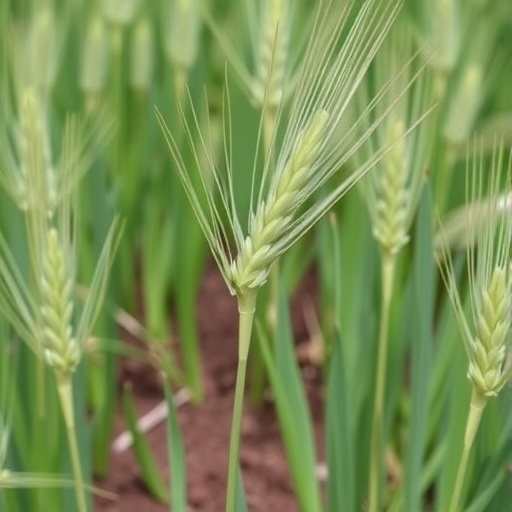Recent advancements in our understanding of plant resilience have been illuminated by groundbreaking research conducted by Professor Michihiro Suga and his team at Okayama University, Japan. Their study revolves around the critical barley protein HvAACT1, which allows certain barley cultivars to thrive in the problematic acidic soils that affect roughly 40% of the world’s arable land. These acidic conditions pose a significant threat to food security as they lead to increased aluminum ion concentrations that are detrimental to root growth and nutrient uptake.
A notable aspect of this research is that it shines a light on how plants have evolved mechanisms to cope with such toxic metal exposure. One effective strategy that some plants, including resilient barley cultivars, have adopted involves the release of organic acids, particularly citrate. These acids possess the ability to bind with aluminum ions in the soil, thereby neutralizing their harmful effects and protecting root systems from damage.
However, not all barley varieties are equipped with this mechanism, which is where the discovery and characterization of the HvAACT1 protein come into play. Unlike conventional barley types, certain cultivars exhibit remarkable adaptations that enable them to release citrate efficiently into the soil. This unique protein acts as a transporter, leveraging its structural capabilities to efficiently expel citrate and reduce soil aluminum toxicity—a feature that is especially remarkable given barley’s general vulnerability to acidic conditions.
The research, published in the esteemed Proceedings of the National Academy of Sciences, showcases the importance of structural biology in understanding such complex biological systems. Utilizing advanced tools such as X-ray crystallography, the research team was able to derive high-resolution images of the HvAACT1 protein. These images reveal intricate details of its architecture, including two distinct but coordinated functional sites. One site is responsible for recognizing citrate, while the other binds protons, allowing for efficient transport through the root system into the surrounding soil.
This dual-site functionality is groundbreaking not only in the context of barley but also in the broader field of transporter biology. Unlike other members of the multidrug and toxic compound extrusion (MATE) family, which typically transport positively charged molecules, HvAACT1 specializes in the export of negatively charged citrate molecules. This could significantly shift existing paradigms concerning the way we understand ion transport mechanisms in plants and their interactions with soil chemistry.
The implications of this newfound knowledge extend beyond theoretical understanding; they lay a foundation for innovative agricultural applications. Professor Suga highlighted the potential to design or breed crops that can withstand acidic soils by leveraging insights gained from the detailed structure of HvAACT1. This could prove instrumental in boosting crop resilience, particularly for smallholder farmers in developing regions who lack access to costly soil amendments.
In addition to actionable agricultural solutions, this discovery provides critical insights into the natural strategies that plants employ to adapt to environmental stresses. Understanding these biological mechanisms enables researchers and agricultural experts to devise more effective strategies for improving soil health and optimizing crop yields, especially in regions plagued by acidity and aluminum toxicity.
The revelation of HvAACT1’s structure marks a significant advancement in our comprehension of plant biochemistry and the ongoing battle against soil degradation. As the global population continues to rise, the pressure to generate more food from limited arable land becomes increasingly urgent. This research not only addresses current agricultural challenges but also serves as a beacon of hope for sustainable practices that can elevate food security.
In summary, the detailed study of the HvAACT1 protein opens new doors for research and application in plant resilience against soil toxicity. It underlines the importance of understanding molecular interactions within plant systems and advances the ongoing quest for sustainable agricultural solutions. As researchers delve further into how these specialized proteins function, we can expect a ripple effect of innovation across agricultural disciplines aimed at addressing one of humanity’s most critical needs: food production.
Achieving greater knowledge of these strategies exposes opportunities for enhancing food security through modern biotechnological efforts, resulting in a two-fold benefit: improved crop yields and minimal environmental impact. The breakthroughs in structural biology reflected in this study, coupled with the insights gained, multiply the chances for worldwide agricultural reforms that could secure food supplies for generations to come.
Professor Suga’s ongoing research marks a pivotal point in understanding plant adaptations. Through structural insights such as those provided by the HvAACT1 transporter, new methodologies for combating agricultural challenges related to soil acidity and aluminum toxicity are bound to emerge. It fosters a renewed sense of urgency in exploring natural plant mechanisms while encouraging multi-disciplinary collaborations necessary to tackle these complex global issues.
In a world increasingly faced with the challenges of climate change and environmental degradation, studies like these become not just valuable scientific discourse but crucial components in shaping future agricultural practices that are both resilient and sustainable.
Subject of Research: Plant resilience mechanisms against aluminum toxicity in acidic soils
Article Title: Structural insights into a citrate transporter that mediates aluminum tolerance in barley
News Publication Date: 5-Aug-2025
Web References: Proceedings of the National Academy of Sciences
References: N/A
Image Credits: Professor Michihiro Suga, Okayama University
Keywords
Life sciences, Agriculture, Soil acidification, Structural biology, Biochemistry, Plant sciences, Crops, Rhizosphere, Food crops, Fertilizers, Molecular biology, Membrane proteins.
Tags: advancements in agricultural researchaluminum ion tolerance in cropsbarley resilience in acidic soilscitrate release in barley cultivarscrop adaptation to toxic soilsenhancing root growth in acidic conditionsfood security and sustainable farminggenetic traits for crop resilienceHvAACT1 protein in plantsinnovative solutions for arable land challengesorganic acids for soil healthplant mechanisms against aluminum toxicity





